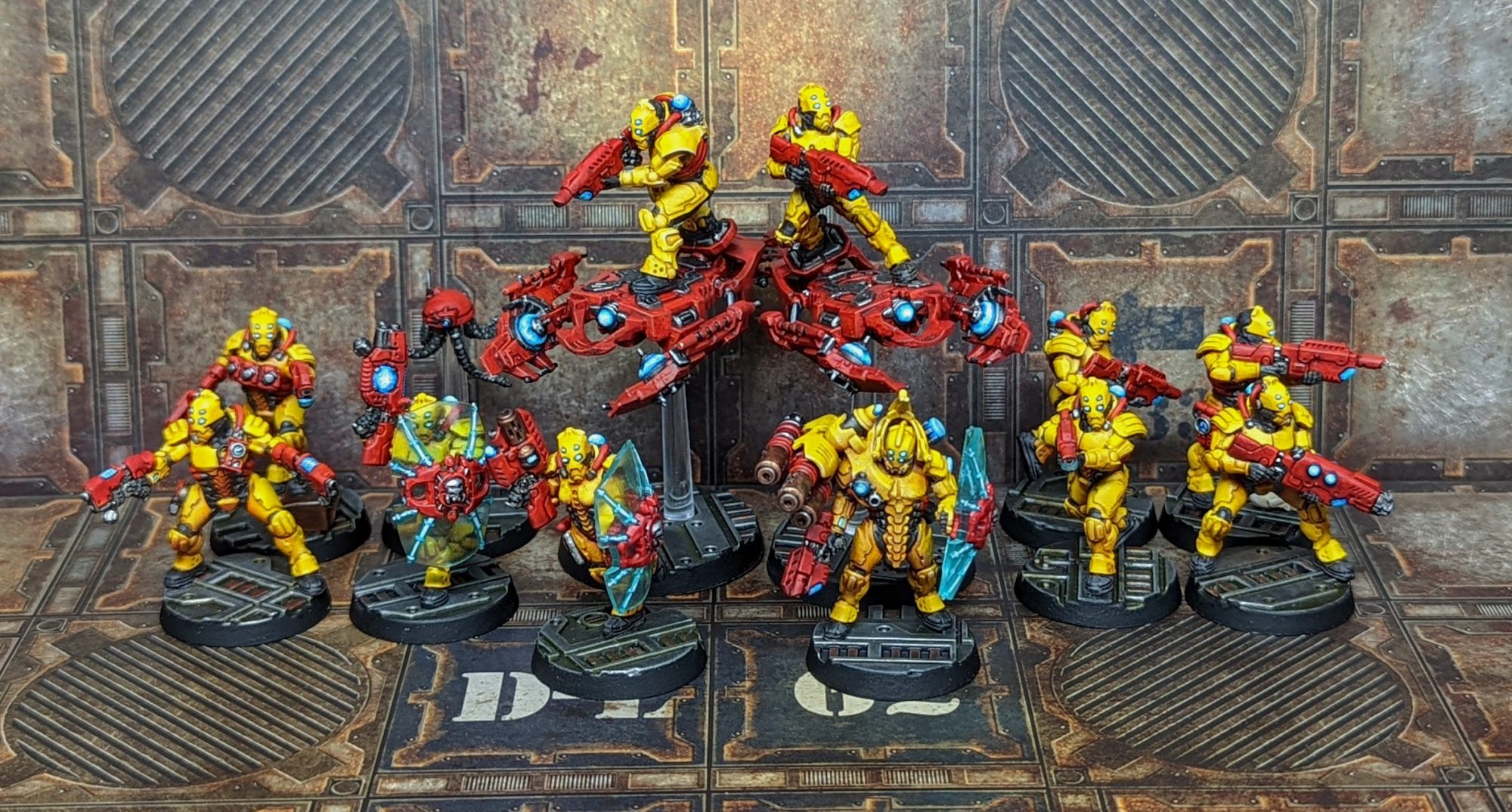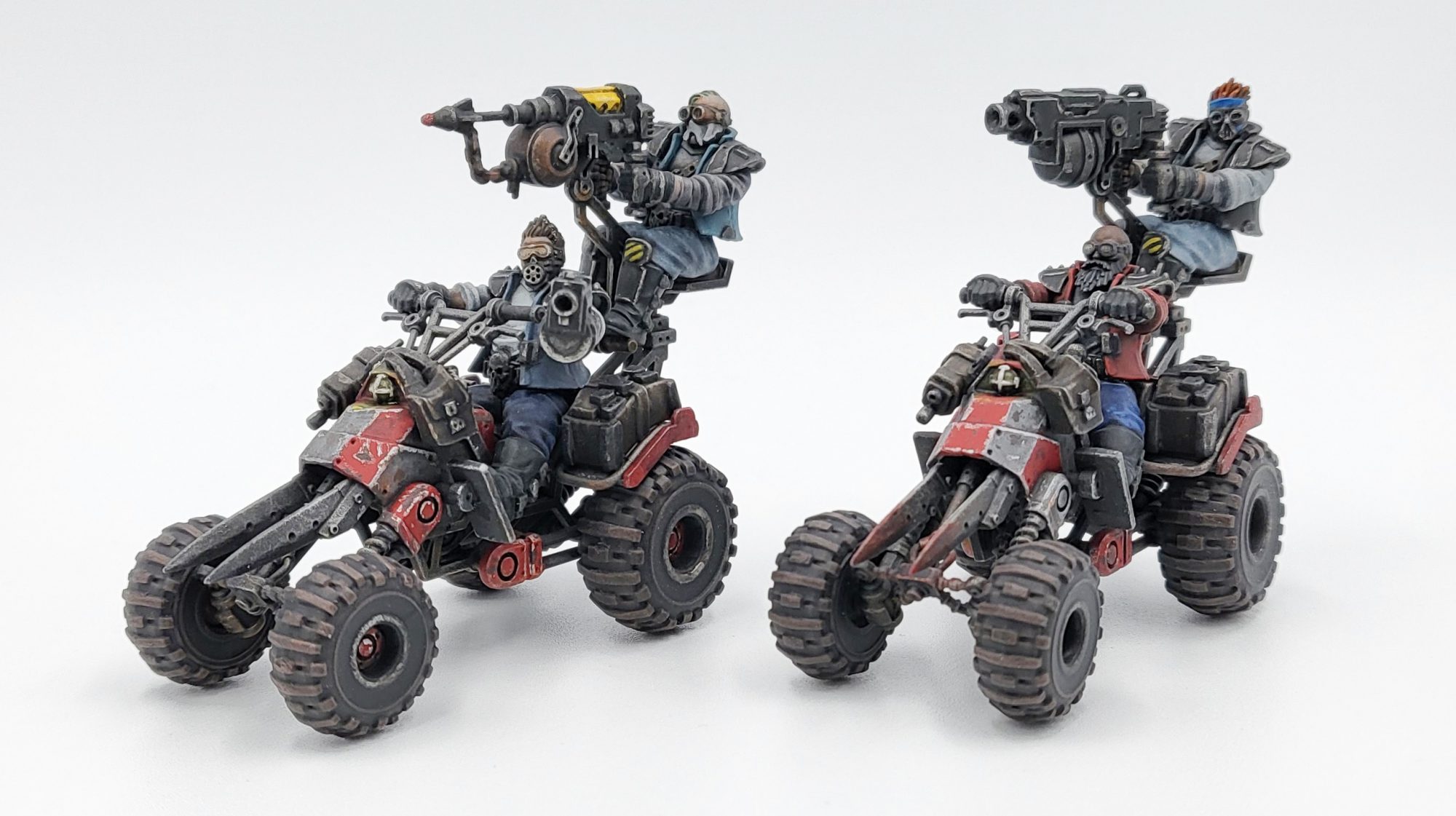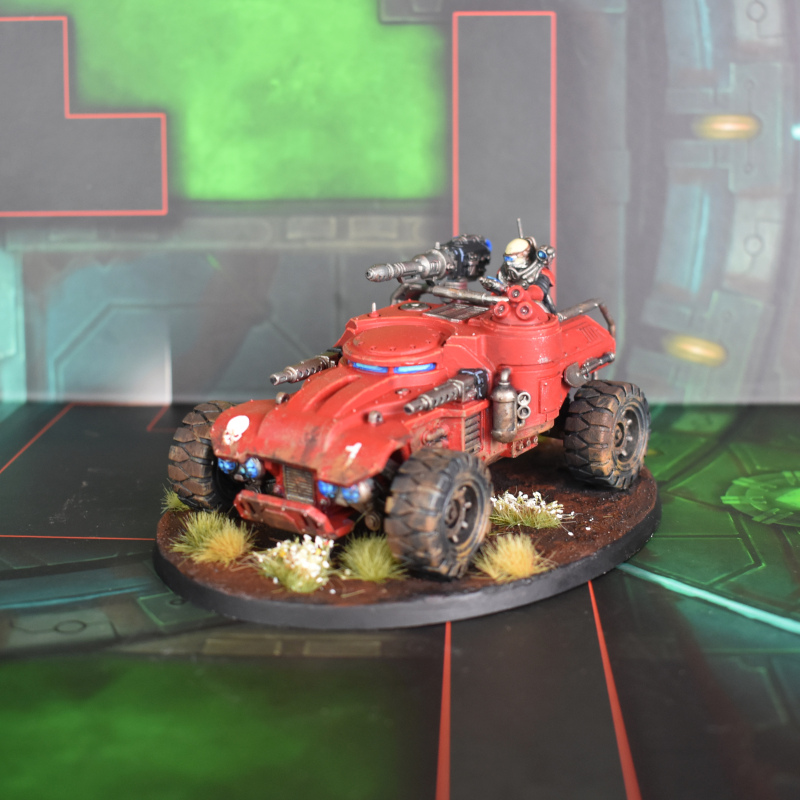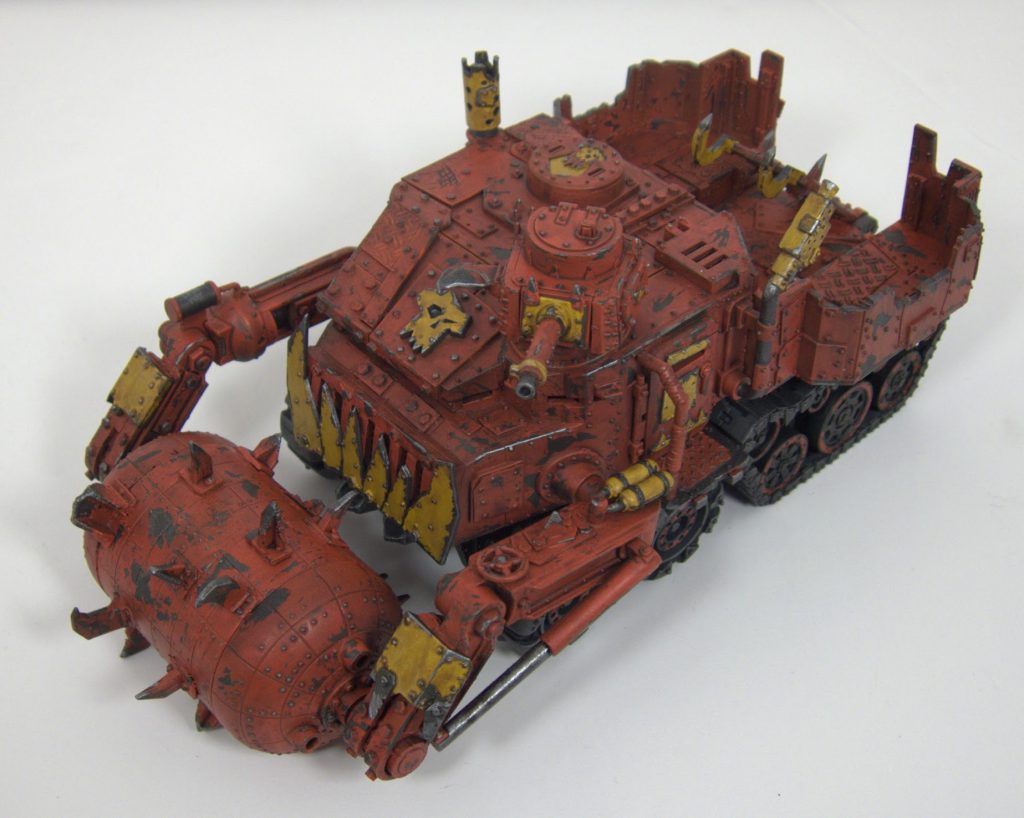This week’s Hammer of Math takes a look at the custom vehicle rules from Book of the Outlands and examines the value of the generic options.
Vehicles are the core component of the new Ash Wastes gameplay. With new levels of toughness and firepower, not to mention new combat and damage rules, the gameplay shifts to something significantly more lethal. While the Ash Waste campaign book itself had limited options, the Book of the Outlands provides options for four custom chassis and five full vehicles (including one option locked to the Orlocks). One of the things that became pretty obvious is that Games Workshop is concerned about custom rides being too powerful. In addition to literally putting a disclaimer in the beginning of the vehicle chapter, they also applied the Jury-rigged rule to make custom vehicles twice as expensive to repair. For the most part that seems like something people will ignore, but on top of that the generic vehicles seem better for the price. So the question for this article is simple; is that actually true and (if so) by how much?

Basics of Vehicle Creation
The custom vehicle rules start off at gang creation with the player choosing a chassis (light, medium, heavy, or walker), and then adding vehicle upgrades, weapons, and vehicle wargear from the custom vehicle equipment list. Players can also choose the type of locomotion for anything but a walker; they can be wheeled or tracked. After gang creation custom vehicles have access to the entire Trading Post and can add anything their gang can get their hands on. Vehicles are limited by how many upgrades can be applied; the three locations (body, drive, and engine) each have a limited number of slots.

Several of the upgrades directly modify stats. Extra Armour adds 1 to the Toughness characteristic of every side for 25 credits. Nitro burner increases the Movement characteristic by 1″ for 15 credits. Reinforced Armour increases the starting HP by 1 for 20 credits. Finally wheeled vehicles can take Tyre Claws and/or All-Wheel Steering to add 1 to the Handling characteristic for 10 credits each. Oddly there’s no way to improve the Save characteristic.
Players who would prefer to paint and play instead of carefully model their custom rides (I don’t understand it but they exist) can instead choose one of five standard rides (four if you’re not Orlock). These vehicles generally come with additional wargear or abilities, and their equipment lists are all unique. The downside is that these vehicles are only permitted to get upgrades from their list. The fun part is that we can examine these stock vehicles and see how much they’re actually “worth” as custom rides by looking at the upgrades. For example raising Toughness via Extra Armour costs 25 credits, so we can peg the value of an all-around Toughness boost at that price. It’s not perfect but it’s a start.

Orlock Outrider Quad
The Orlocks get access to a unique vehicle which is extremely agile and fast, but about as fragile as a regular ganger (which makes sense given that this vehicle is basically two gangers, an engine, a gun, and some wheels.). At 80 credits it Move characteristic of 9″, a 4/3/3 Toughness profile, 2 HP, 4+ Handling, and a 5+ Save. It has one hardpoint with a single arc and the Agile and Dedicated Gunner abilities which make it insanely maneuverable.
The Light Vehicle chassis is 50 credits. It needs 2″ of movement (+20 credits), an extra Toughness on the front (call it +10 credits), one more HP (+20 credits), 2 better handling (+20 credits), and there’s no way to get the Outrider’s special rules. Even if you ignore those special rules the Outrider gets a 50 credit discount over a roughly equivalent custom ride, not to mention the option to harpoon your enemies at gang creation.
Wolfquad
The Wolfquad is the generic brother of the Orlock Outrider Quad. At 70 credits it has a Movement characteristic of 8″, a 3/3/3 Toughness profile, 2 HP, 5+ Handling, and a 5+ Save. It also has the Agile rule which the custom light chassis does not. The light chassis needs 1″ of movement (+10 credits), one more HP (+20 credits), one more Handling (+10 credits) to catch up, which totals up to 90 credits and means the Wolfquad has a 20 credit discount.

Ridgerunner
The Ridgerunner is the stock medium vehicle that travels through the wastes. 95 credits gets you a 7″ Movement characteristic, a 5/4/4 Toughness profile, 3 HP, 7+ Handling, and a 5+ Save. It comes with a free transport bed and two weapon hardpoints. The medium vehicle needs 1″ of movement to catch up (+10 credits) along with a second hardpoint (+40 credits) and a transport bed (+15 credits), but it’s actually better in terms of Toughness and Save program. Assuming the Toughness is a 15 credit discount, there’s no wargear or upgrade that improves the Save characteristic. At best I can treat it like a Toughness boost for 25 credits. That sums up to an equivalent value of 205 credits, which means the Ridgerunner gets roughly a 110 credit discount. The Ridgerunner also gets unlimited access to missile launchers, which is both hilarious and terrifying.

Rockgrinder
Hitting up the heavy equivalent is the 145 credit Rockgrinder, a brutal truck/mining rig which is ubiquitous in rugged areas where resilience is just as important as cargo capacity. It’s slow with a 5″ Movement characteristic, but the 7/7/6 Toughness, 4 HP, and 4+ save make it hard to kill. Just don’t push it too hard; the 8+ Handling isn’t the most reliable. The vehicle is also well equipped with a pair of hardpoints with two arcs each and a transport area. The 175 credit heavy chassis is pretty close in terms of stats, with 1 more toughness on the rear (call it a 10 credit discount) and two hardpoints. However the transport bed (+15 credits) and pair of extra arcs on the weapons (+30 credits) mean that the Rockgrinder has a 65 credit discount.

Ridgehauler
The final vehicle technically has no customizable equivalent (in fact the book explicitly states that they cannot be made in the wastes, which to me feel likes a challenge more than an statement of fact), but the Cargo-8 Ridgehauler is so insane that it deserves some recognition. At 230 credits this beast is not cheap, but the profile more than justifies it. With a 7″ Movement characteristic it’s as fast as a Ridgerunner, the 9/8/8 Toughness profile is insane, and even if you could reliably wound the thing it has 6 HP with a 3+ save. The 7+ Handling isn’t great but you can buy both Tyre Claws and All-Wheel Steering for 20 credits to make it 5+. It comes standard with a single hardpoint with two firing arcs and a transport bed.
Where things get hilarious is that you can build it up even more. For 50 credits you can get an armoured container which adds two hardpoints with all-around firing arcs, counts as a Ammo Cache that cannot be exhausted, and it provides you with D3x10 credits if the vehicle survives the mission. There’s also a 30 credit promethium tank option which gives you D6x10 credits if it survives and lets every Flame weapon within 3″ become Plentiful instead of Scarce, but it can also explode and do fun things if it’s hit by a particularly hard shot. Players can take things even further by adding up to 4 Ridgehauler trailers at 130 credits each which can also carry a container or tank.
Going from a 175 credit heavy chassis to a 280 credit Ridgehauler with a container requires a lot. You need multiple Toughness boosts (+35 credits assuming increasing just the front is the equivalent of 10 credits), 2 more HP (+40 credits), an extra hardpoint (+40 credits) and an extra 7 firing arcs (+105 credits), 2″ more movement (+20 credits), +1 to Handling (+10 credits), transport bed (+15 credits), a Weapons Stash (+20 credits, although the upgrade can be exhausted), and pay whatever the equivalent of boosting a Save will be (assuming +25 credits here). That’s roughly a 485 credit total, meaning the Ridgehauler has an absolutely insane 205 credit discount. Not to mention it makes you money while giving you the option to upgrade it further.

Shiny and Chrome
There’s no easy way to put it; for whatever reason Games Workshop went out of their way to make the custom vehicle rules extremely suboptimal compared to the standard offerings. Ignoring the fact that every custom vehicle has a penalty associated with repairs, players who make custom vehicles put themselves at a huge disadvantage compared to spending that 400 credits on a Ridgehauler or a Ridgerunner. That’s a shame because the custom rules are fun, especially when you do things like make a hovering murder pod that drops caltrops everywhere or a flame-spewing pickup loaded with lobo-slaves and a complete disregard for safety regulations. Fortunately Necromunda is a game where tweaks and Arbitrator decisions are encouraged. For example, there’s nothing stopping an Arbitrator from running a campaign where every vehicle uses the custom rules but ignores the penalty to repair costs. It’s something I’m considering.
Thanks for reading! If you have any questions or comments feel free to drop us a note in the Comments below or email us at contact@goonhammer.com. That’s also the best way to suggest topics for future articles.


